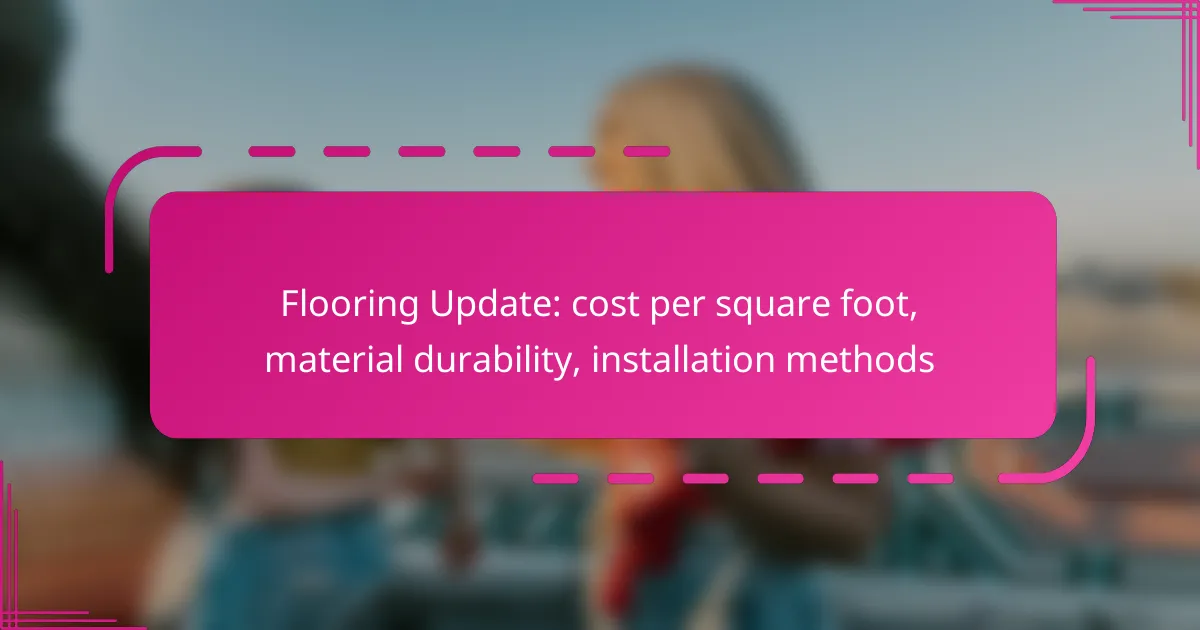When updating your flooring, understanding the cost per square foot is essential, as it varies widely based on material quality and installation complexity. Durability is another key factor, with options like hardwood, vinyl, tile, and laminate each offering unique benefits. Additionally, the installation method chosen can significantly influence both the overall cost and the longevity of your flooring investment.

What is the cost per square foot for flooring in the United States?
The cost per square foot for flooring in the United States varies significantly based on the material chosen, with prices typically ranging from low to high depending on quality and installation complexity. Homeowners should consider both the initial cost and long-term durability when selecting flooring options.
Average cost for hardwood flooring
Hardwood flooring generally costs between $5 to $15 per square foot, depending on the type of wood and finish. Exotic woods or high-end finishes can push prices even higher, while domestic options may be more affordable.
Installation costs for hardwood can add an additional $3 to $8 per square foot, depending on the complexity of the job and the contractor’s rates. It’s advisable to get multiple quotes to ensure competitive pricing.
Average cost for laminate flooring
Laminate flooring is typically less expensive, averaging around $1 to $5 per square foot. This budget-friendly option mimics the appearance of wood or stone but is made from composite materials.
Installation costs for laminate flooring are usually lower as well, ranging from $1 to $3 per square foot. Many homeowners opt for DIY installation, which can further reduce overall expenses.
Average cost for tile flooring
The cost for tile flooring can vary widely, generally ranging from $1 to $20 per square foot based on the type of tile selected, such as ceramic, porcelain, or natural stone. Higher-end tiles, like marble or granite, can significantly increase costs.
Installation for tile flooring may add another $4 to $10 per square foot, depending on the complexity of the layout and the type of substrate required. Proper preparation is essential for a durable finish.
Average cost for carpet flooring
Carpet flooring usually costs between $2 to $7 per square foot, with prices influenced by fiber type, pile height, and brand. Synthetic fibers tend to be more affordable, while natural fibers like wool are on the higher end.
Installation costs for carpet can range from $1 to $4 per square foot. It’s important to factor in the cost of padding, which can enhance comfort and durability.
Factors affecting flooring costs
Additionally, the complexity of the installation, such as the need for subfloor preparation or custom cuts, can increase overall expenses. Homeowners should carefully evaluate their needs and budget before making a decision.

What are the most durable flooring materials?
The most durable flooring materials include hardwood, vinyl, tile, and laminate, each offering unique strengths. When selecting a flooring type, consider factors such as wear resistance, maintenance needs, and suitability for your environment.
Durability of hardwood flooring
Hardwood flooring is known for its longevity and can last several decades with proper care. It is resistant to wear and tear but can be susceptible to scratches and moisture damage, making it less ideal for high-moisture areas like bathrooms.
To enhance durability, choose hardwood species like oak or maple, which are denser and more resilient. Regular maintenance, including refinishing every few years, can significantly extend its lifespan.
Durability of vinyl flooring
Vinyl flooring is highly durable and resistant to water, making it suitable for kitchens and bathrooms. It can withstand heavy foot traffic and is less prone to scratches compared to hardwood.
Look for luxury vinyl planks (LVP) that offer thicker wear layers for added protection. Vinyl is also easy to clean and maintain, making it a practical choice for busy households.
Durability of tile flooring
Tile flooring is one of the most durable options available, resistant to scratches, moisture, and stains. It is ideal for areas prone to spills and heavy use, such as kitchens and entryways.
Porcelain tiles, in particular, are denser and less porous than ceramic, providing superior durability. However, tile can be cold and hard underfoot, so consider adding rugs for comfort.
Durability of laminate flooring
Laminate flooring offers a good balance of durability and affordability. It is resistant to scratches and fading, making it suitable for high-traffic areas.
However, laminate is less water-resistant than other materials, so it may not be the best choice for bathrooms or basements. Opt for higher-quality laminate with a thicker wear layer for better performance.

What are the installation methods for flooring?
There are several installation methods for flooring, each with its own advantages and considerations. The choice of method can impact the overall cost, durability, and ease of installation.
Glue-down installation method
The glue-down installation method involves adhering flooring materials directly to the subfloor using a strong adhesive. This method is commonly used for vinyl and some types of hardwood flooring, providing a stable and secure fit.
One key consideration is the drying time of the adhesive, which can vary from a few hours to a day. Proper surface preparation is crucial to ensure a successful bond and prevent future issues like warping or lifting.
Nail-down installation method
Nail-down installation is primarily used for solid hardwood flooring. In this method, boards are secured to the subfloor using nails or staples, creating a sturdy and long-lasting floor.
This technique requires a wooden subfloor and is best suited for areas with low humidity. It is essential to ensure that the nails are driven at the correct angle to avoid damaging the wood and to maintain the integrity of the installation.
Floating installation method
The floating installation method allows flooring to “float” above the subfloor without being attached. This is commonly used for laminate and engineered wood flooring, where planks interlock to create a seamless surface.
This method is advantageous because it can be installed over various surfaces, including concrete and existing flooring. However, it’s important to leave expansion gaps around the perimeter to accommodate changes in temperature and humidity.
Professional installation vs DIY
Choosing between professional installation and DIY depends on your skill level and the complexity of the flooring type. Professional installers can ensure a high-quality finish and may be necessary for intricate patterns or materials.
For DIY enthusiasts, simpler flooring options like laminate or vinyl can be manageable with the right tools and instructions. However, it’s crucial to research and understand the installation process to avoid costly mistakes.

What factors should you consider when choosing flooring?
Choosing flooring involves evaluating several key factors, including foot traffic, climate conditions, and desired aesthetics. Each of these elements plays a crucial role in determining the best flooring material and installation method for your space.
Foot traffic and usage
Foot traffic and usage patterns significantly influence flooring selection. High-traffic areas, such as hallways and living rooms, require durable materials like hardwood, tile, or luxury vinyl that can withstand wear and tear. For lower-traffic spaces, softer options like carpet may be more suitable.
Consider the intended use of each room. For example, kitchens and bathrooms benefit from water-resistant materials, while bedrooms can prioritize comfort and warmth. Assessing how each space will be used helps in making an informed choice.
Climate and moisture levels
Climate and moisture levels are critical when selecting flooring materials. In humid regions, moisture-resistant options like tile or vinyl are ideal, as they prevent warping and mold growth. Conversely, in dry climates, hardwood may be more suitable, provided it is properly sealed.
It’s also essential to consider the specific moisture levels of your home. Basements, for instance, often require specialized flooring solutions to combat dampness. Always check local humidity averages and choose materials that can handle those conditions effectively.
Style and aesthetics
Style and aesthetics play a vital role in flooring decisions, as they contribute to the overall look and feel of your space. Consider the existing decor and color schemes when selecting flooring materials. For a modern look, sleek tiles or polished concrete may be appropriate, while traditional homes might benefit from classic hardwood.
Additionally, think about the texture and finish of the flooring. Glossy finishes can create a sense of elegance, while matte options may lend a more rustic feel. Balancing style with functionality ensures that your flooring choice enhances your home’s aesthetic appeal without compromising durability.
